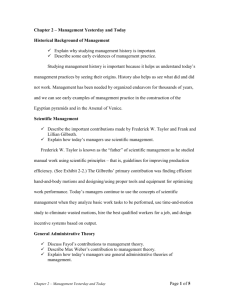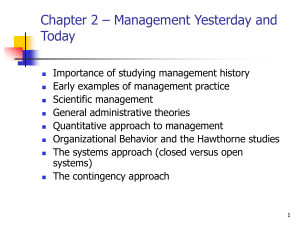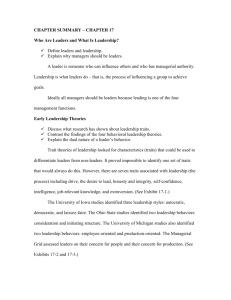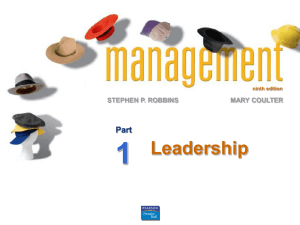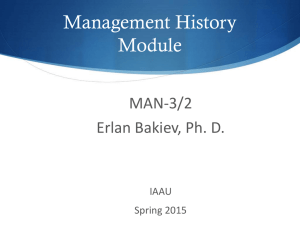here
advertisement
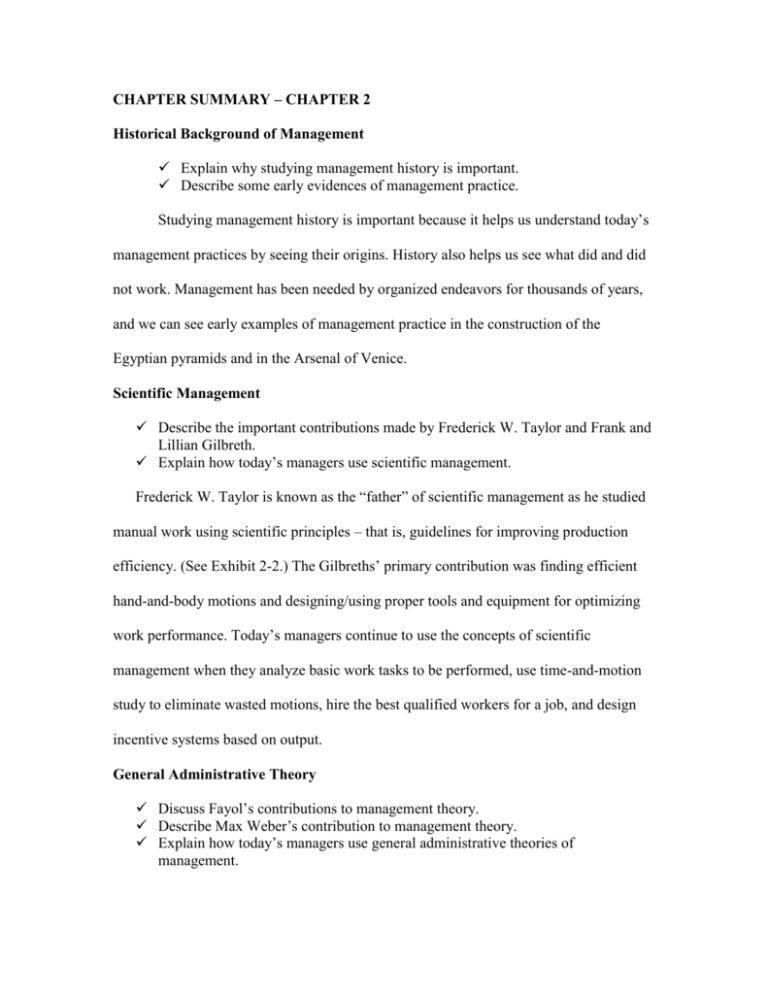
CHAPTER SUMMARY – CHAPTER 2 Historical Background of Management Explain why studying management history is important. Describe some early evidences of management practice. Studying management history is important because it helps us understand today’s management practices by seeing their origins. History also helps us see what did and did not work. Management has been needed by organized endeavors for thousands of years, and we can see early examples of management practice in the construction of the Egyptian pyramids and in the Arsenal of Venice. Scientific Management Describe the important contributions made by Frederick W. Taylor and Frank and Lillian Gilbreth. Explain how today’s managers use scientific management. Frederick W. Taylor is known as the “father” of scientific management as he studied manual work using scientific principles – that is, guidelines for improving production efficiency. (See Exhibit 2-2.) The Gilbreths’ primary contribution was finding efficient hand-and-body motions and designing/using proper tools and equipment for optimizing work performance. Today’s managers continue to use the concepts of scientific management when they analyze basic work tasks to be performed, use time-and-motion study to eliminate wasted motions, hire the best qualified workers for a job, and design incentive systems based on output. General Administrative Theory Discuss Fayol’s contributions to management theory. Describe Max Weber’s contribution to management theory. Explain how today’s managers use general administrative theories of management. Henri Fayol believed that management was common to all business endeavors but also was distinct from other business functions. He developed 14 principles of management from which many current management concepts have evolved. (See Exhibit 2-3.) Weber described an ideal type of organization he called a bureaucracy, the characteristics of which many of today’s large organizations still exhibit. (See Exhibit 24.) Today’s managers still use general administrative theories when they perform the functions of management and structure their organizations so that resources are used efficiently and effectively. Quantitative Approach Explain what the quantitative approach has contributed to the field of management. Discuss how today’s managers use the quantitative approach. The quantitative approach involves applications of statistics, optimization models, information models, and computer simulations to management activities. Today’s managers use the quantitative approach especially when making decisions as they plan and control work activities such as allocating resources, scheduling work, or determining optimum inventory levels. Toward Understanding Organizational Behavior Describe the contributions of the early advocates of OB. Explain the contributions of the Hawthorne Studies to the field of management. Discuss how today’s managers use the behavioral approach. The contributions of the early OB advocates (Robert Owen, Hugo Munsterberg, Mary Parker Follett, and Chester Barnard) were varied and distinct, but all believed that people were the most important asset of the organization and should be managed accordingly. (See Exhibit 2-5.) The Hawthorne Studies had a dramatic impact on management beliefs about the role of people in organizations, which led to a new emphasis on the human behavior factor in managing. The behavioral approach has largely shaped how today’s organizations are managed. Many of our current theories of motivation, leadership, group behavior and development and other behavioral issues can be traced to the early OB advocates and the conclusions from the Hawthorne Studies. The Systems Approach Describe an organization using the systems approach. Discuss how the systems approach helps us understand management. Using the systems approach, an organization takes in inputs (resources) from the environment and transforms or processes these resources into outputs that are distributed into the environment. (See Exhibit 2-6.) The systems approach helps us understand management since managers must ensure that all the interdependent units are working together so that the organization’s goals can be achieved. It also helps managers realize that decisions and actions taken in one organizational area will affect others and vice versa. Finally, the systems approach helps managers recognize that organizations are not self-contained, but instead rely on their environment for essential inputs and as outlets to absorb their outputs. The Contingency Approach Explain how the contingency approach differs from the early theories of management. Discuss how the contingency approach helps us understand management. Unlike early theories of management which were generally assumed to be universally applicable, the contingency approach says that organizations are different, face different situations, and require different ways of managing. (See Exhibit 2-8.) The contingency approach helps us understand management because it stresses there are no simplistic or universal rules for managers to follow. Instead, managers must look at their situation and determine that if this is the way my situation is, then this is the best way for me to manage. Current Trends and Issues Explain why we need to look at the current trends and issues facing managers. Describe the current trends and issues facing managers. The current trends and issues facing managers are changing the way managers do their jobs. These current trends and issues include customer service management and innovation (both of which were introduced in Chapter 1), globalization, ethics, workforce diversity, entrepreneurship, e-business, and knowledge management and learning organizations.
